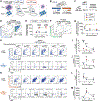Regulatory T cells constrain T cells of shared specificity to enforce tolerance during infection
- PMID: 40014689
- PMCID: PMC12006836
- DOI: 10.1126/science.adk3248
Regulatory T cells constrain T cells of shared specificity to enforce tolerance during infection
Abstract
During infections, CD4+ Foxp3+ regulatory T (Treg) cells must control autoreactive CD4+ conventional T (Tconv) cell responses against self-peptide antigens while permitting those against pathogen-derived "nonself" peptides. We defined the basis of this selectivity using mice in which Treg cells reactive to a single prostate-specific self-peptide were selectively depleted. We found that self-peptide-specific Treg cells were dispensable for the control of Tconv cells of matched specificity at homeostasis. However, they were required to control such Tconv cells and prevent autoimmunity toward the prostate after exposure to elevated self-peptide during infection. Notably, the Treg cell response to self-peptide did not affect protective Tconv cell responses to a pathogen-derived peptide. Thus, self-peptide-specific Treg cells promoted self-nonself discrimination during infection by selectively controlling Tconv cells of shared self-specificity.
Conflict of interest statement
Figures






References
MeSH terms
Substances
Grants and funding
LinkOut - more resources
Full Text Sources
Molecular Biology Databases
Research Materials

